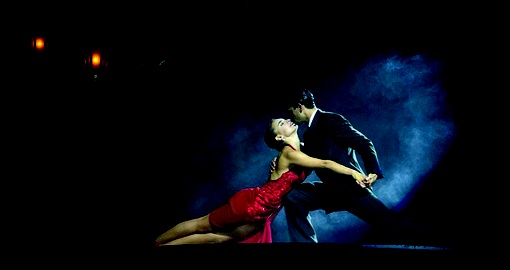World Tango Festival in Buenos Aires
Below is a sample itinerary of a past Goway Group. It is provided to give you an idea of what we have already done & what you might also consider doing.
However, because of timing, your own group's special interests and budget, we expect to custom make a program just for you. Contact your favorite travel agent click on "Inquire about this Trip" to fill out a request for a group quotation.
The 2011 Tango Festival and World Championship is taking place from August 12 to 30, in fabulous Buenos Aires. There is no place to celebrate the art of the tango except in its birthplace, Argentina. The festival is a celebration of the art of tango and many events are free to the public: live performances, concerts, films, exhibitions, open classes, meetings and conferences, among many others.
After the festival, the World Championship of Tango Dance begins with the participation of the best local, national and international dancers who take part in the competitions of Salon Tango and Stage Tango. The 10-day competition at various venues is organized based on three rounds: The Qualifying Round, The Semifinals and The Final.
If you love the tango, belong to a dance club or even want to learn how, why not get your club or group together and take off to Argentina!
Buenos Aires Arrival
Welcome to Argentina. Upon arrival you will be met at Ezeiza International Airport by Goway’s local representative and transferred to your hotel.
About Buenos Aires: This capital city is a complex, energetic, and seductive city stretching along the Rio de la Plata. It is busily renovating its wealth of architecture, much of which dates from nearly a century ago, in anticipation of its 2010 bicentennial. European immigrants to Buenos Aires, mostly from Spain and Italy, brought with them the warm ways of Mediterranean culture, where friends, family, and conversation were the most important things in life. Stroll through the neighbourhoods of Recoleta or Palermo, full of buildings with marble neoclassical facades on broad tree-lined boulevards, or tour the historic 9 de Julio Avenida, which was designed to rival Paris' Champs Elysées. The city is also well known for its colourful neighbourhoods that are small and highly individualized, each with its own characteristics.
Accommodation: Buenos Aires Hotel (8 nights)
Buenos Aires City Tour Plus Eva Peron Museum
This fascinating 3-hour tour of the elegant turn-of-the-century districts earned Buenos Aires the soubriquet of the Paris of South America. From the charming cobbled alleys and colonial architecture of San Telmo along to the Plaza de Mayo, dominated by the Casa Rosada (Government House), the Nación Bank, the Cathedral and the original Parliament House, up the leafy Avenida de Mayo towards the imposing grandeur of the Palace of Congress and then on to finish at the historically fascinating Recoleta Cemetery, you will discover the facts, stories and anecdotes that make up the colourful tapestry of the history of Buenos Aires. The city tour will also include entry to the Eva Peron Museum. Evita, a larger-than-life icon, now has her own museum housed in a mansion constructed for the Carabassa family during the first decade of the 20th century. This beautiful building was declared a National Historical Monument in 1999. (BD)
Tango Show & Dinner at Tango Porteno
In the evening Enjoy a typically Argentine first-class meal, be it the traditional steak, chicken or Patagonian lamb with a mouth-watering array of salads as well as any of a number of excellent pasta dishes before settling down for a two-hour tango show which includes some of the best-loved songs, music and dances performed by skilled musicians and dancers.
La Boca Neighbourhood Tour
We will also explore the colourful neighborhood of La Boca, the soul of the city and the place where tango was born. This picturesque district sits on the river mouth of the Riachuelo, and is home to the famous Caminito Street, scarcely 100 metres long, yet very much an emblematic post-card of the city. Designed by the Italian-Argentine artist Benito Quinquela Martín at a disused rail port terminal just beyond the iron cantilevered Puente de la Boca which bridges the river, it is a short yet busy pedestrian alley of brightly-painted houses which cluster above the cobblestones. The sheets of corrugated-iron shimmer with glossy blues, reds, yellows and greens and recall the original colours of the leftover paint with which the dockworkers painted their homes in the 19th century. Below these precarious structures, a man in a trilby hat and a white silk scarf knotted around his neck intones one of the best-known of all tangos, Caminito, as his fingers rhythmically knead the bandoneon, originally the Genovese version of the accordion. Perhaps there will also be a couple of dancers clasped together, lost in the intricately subtle moves that the music demands. While in surrounding streets you can buy souvenirs to suit all tastes, in the Caminito street itself there are oil and watercolours for sale, painted by local artists and depicting classic scenes from Buenos Aires life. Expect to bargain for these, for not only is the conversation that stems from this a national pastime, it is also considered to be good manners. (B)
Tango Lessons at Café Tortoni
Café Tortoni is a part of the city’s history and is a must for Tango lovers. After the dance lessons (approximately 1 hour) snacks and coffee or tea are available. Afternoon is at leisure to enjoy the wonderful ambience of Buenos Aires. (B)
Accommodation: El Mapi Hotel or similar (2 nights)
Tango Lessons at Café Tortoni.
1 hour lesson. Afternoon is at leisure. (B)
Full Day Gaucho Fiesta
Today you experience a colourful and fun day at an estancia on the outskirts of Buenos Aires with the opportunity to try out your own equestrian skills before watching the experts. After arriving at the estancia and sampling the traditional empanadas, meat pasties that are either oven-baked or deep-fried, you may visit the grounds on foot or take the opportunity to ride round on horseback, enjoying the comfortable sheepskin cushioning the saddle with the reins resting in one hand. The gaucho riding style has developed over the centuries with comfort as the main priority as they spent –and still do- many hours in the saddle, buckling their blankets, sheepskins and ponchos over the saddle to be used as sleeping mat and blanket at night. The very pace of the horse itself is gentle, with a particular easy loping canter which both horse and rider can keep up for hours if necessary. After a short ride, lunch is served at long trestle tables where everybody sits down together to enjoy the famous asado with slabs of tasty beef and ribs roasted slowly over a charcoal or wood fire, preceded by chorizo sausages or morcilla (black sausage) washed down with Argentine wines. After lunch, the gauchos invite you to share in some of their time-honoured customs of folksong and dance. Wearing the typical bombacha de campo -the cuffed pleated trousers- calf-length boots and wide leather belt, the gauchos dance opposite their chinas who swirl from side to side in their long ruffled dresses, in a display of courtship and chivalry. After this, the entertainment shifts location to a neighbouring field for an impressive show of the skills that are in fact part and parcel of the gaucho’s animal-herding job, combining precision with speed. The tour is shared with other visitors. (BL)
Tango Lessons at the Estancia
Our tango lessons today will be held in the countryside at the estancia. After watching the sunset from the ranch return back to the city and enjoy the evening on your own.
Tigre & Delta Tour
Just 20 miles north of Buenos Aires lies the town of Tigre, named after the South American tiger or wildcat which once roamed the dense tropical forests of the region. The port town was founded in the early 1800’s welcoming vessels of all sizes which shipped wood and fruit to Buenos Aires. Towards the late 1800s, the town started to develop its tourist potential which has increased steadily over the decades. From the boatyards to the elaborate rowing clubhouses constructed by immigrant populations of the 19th century, the Belle Epoque left its mark with the ornate architectural style of the period, endowing the town with an eclectic and fun personality. One of the town’s main attractions is the Fruit Market, a complex of stalls, galleries and stands which swarm over the quays, a magnet for tourists and shoppers keen to sample the wares of the craftsmen from the many neighbouring islands; wickerwork baskets; exotic plants and flowers; furniture carved from local wood; home-made candles, honey and oils; a mouth-watering array of fruit from kakis and passion fruit to every imaginable variety of citrus. Today’s half day tour begins with the train ride from Maipú station in the suburb of Olivos. El Tren de la Costa is a modern and comfortable train which runs on the old coastal railway line built by the English in the late 1800s, one of three which used to originate in the main downtown Retiro train-station. From the renovated Delta station at the end of the line, it is a short walk to the pier where the long wooden launches depart for different islands, carrying schoolchildren, visitors, weekend home owners and sometimes even chickens or other farmyard animals. The launches chug past luxury yachts and the market barges carrying all kinds of provisions as well as dredgers and fishing canoes, allowing for a unique glimpse into life on the river. (B)
San Telmo Markets
After your Tigre tour you will be dropped in the old district of San Telmo where you can experience the celebrated antiques market. The narrow cobbled streets and colonial architecture conjure up the essence of Buenos Aires a hundred years ago. The fair is held every Sunday from late morning until late afternoon in Plaza Dorrego, a large raised square packed with stalls selling anything from beer coasters, old magazines and other curious knick-knacks to crystal goblets, chandeliers and Victorian gold jewellery. Once again, the bargaining proviso holds in good stead. In the surrounding streets, performance artists sing and dance tango, hold puppet shows and pose for interminable periods of time as living statues. Behind them, entrances to art galleries and yet more antique and curiosity shops invite you into finger-worn chamois gloves, admire marble statues and pore over postcards of Buenos Aires in the 1950s. Take your time exploring, taxis are readily available back to your hotel when you are finished eating, browsing and shopping.
Buenos Aires at Leisure
Morning and afternoon are at leisure. (BD)
Buenos Aires Departure
Day at leisure for last-minute shopping. Late checkout from your hotel has been arranged. You will then be picked up for your airport transfer to Ezeiza International Airport for your outbound flight. (B)
Get a Trip Quote Order a Brochure

















